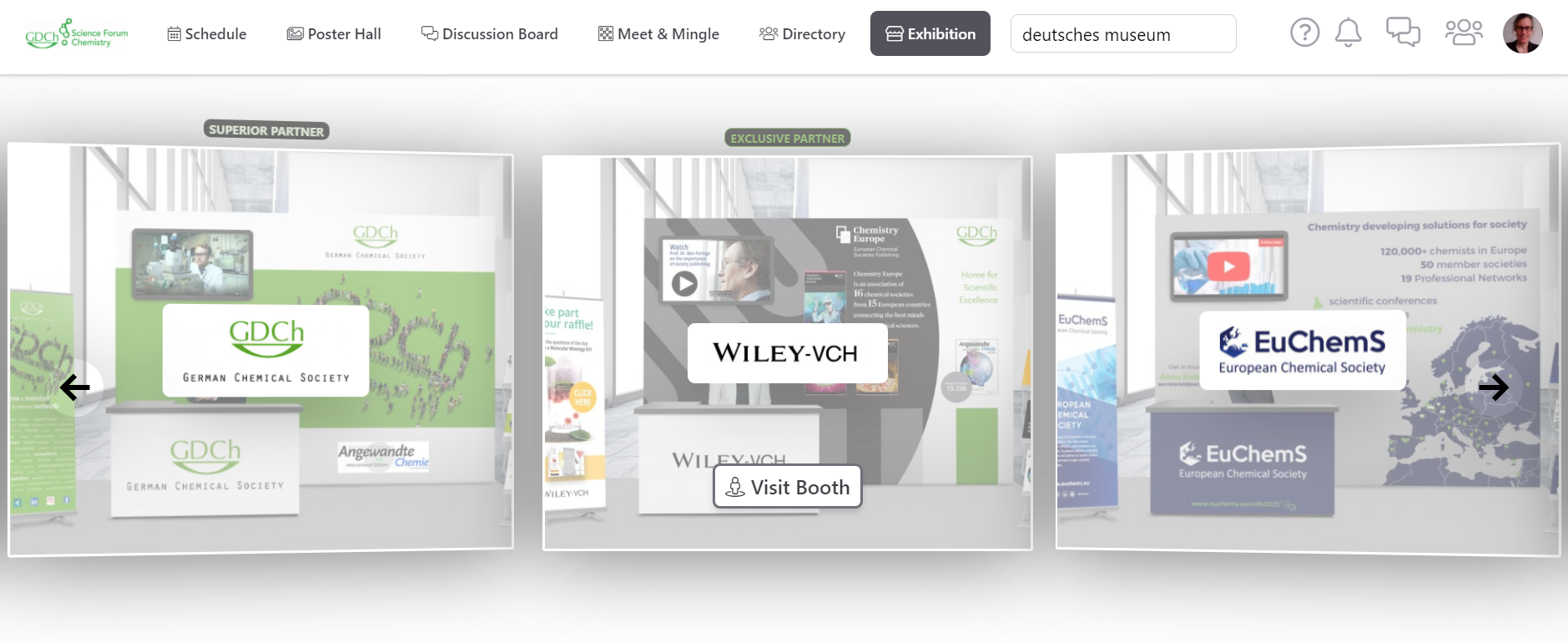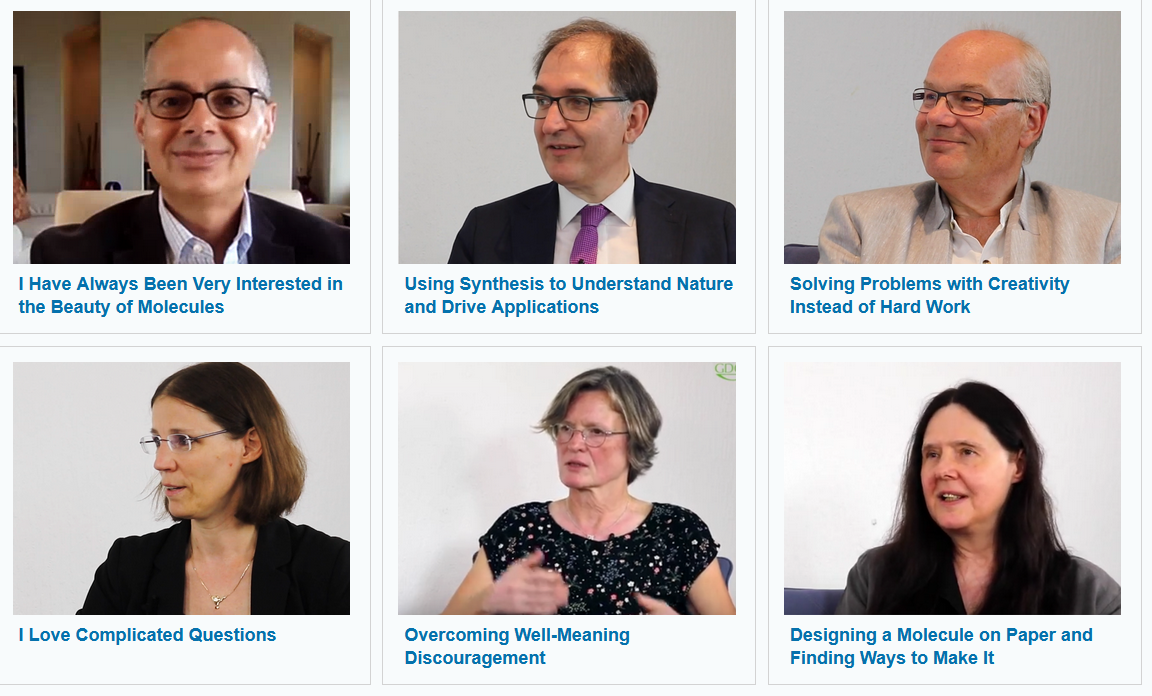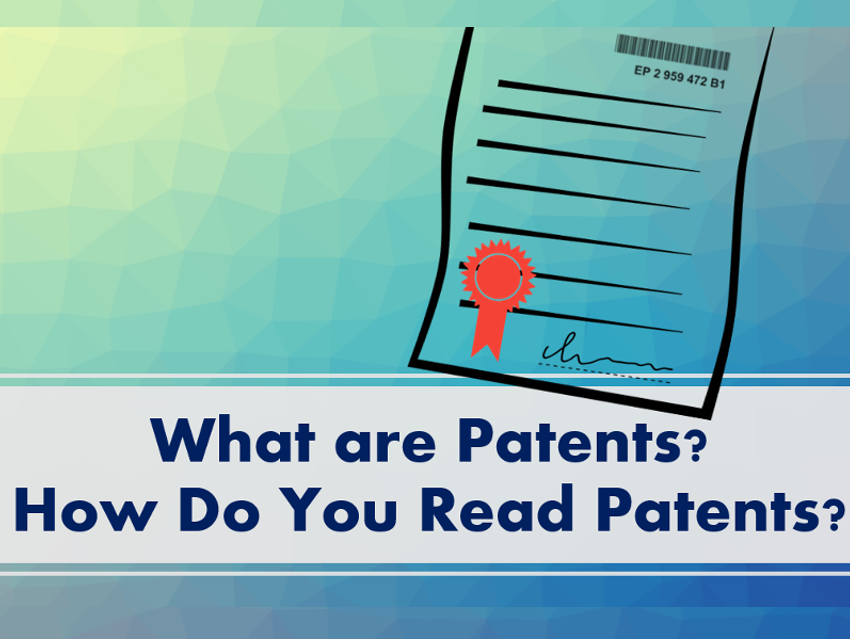The Wissenschaftsforum (Science Forum Chemistry, WiFo) is the most important chemistry congress in the German-speaking world. It is organized every two years by the German Chemical Society (GDCh). Because of the coronavirus pandemic, this year it was held online from August 29 to September 1. The GDCh used this as an opportunity to hold the meeting entirely in English for the first time and explicitly invited foreign colleagues to participate. About 1,000 participants came from more than 20 countries, including China, USA, and Israel—and, of course, many from the German chemistry community.
The motto “Chemists Create Solutions” was chosen to point out that chemists play a crucial role in solving societal challenges and to emphasize the importance of collaboration across disciplinary and geographical boundaries. This was emphasized by the President of the GDCh, Peter R. Schreiner, Professor at the University of Gießen, in his opening speech.
The President of the Society of Austrian Chemists (GÖCH), Peter Gärtner, Professor at the Technical University of Vienna, highly values the cooperation with the GDCh, among others at this meeting. The largest biannual meeting of the GÖCH, the Austrian Chemistry Days, has been postponed until September 2022 due to the COVID-19 pandemic [1].
Another Online Meeting
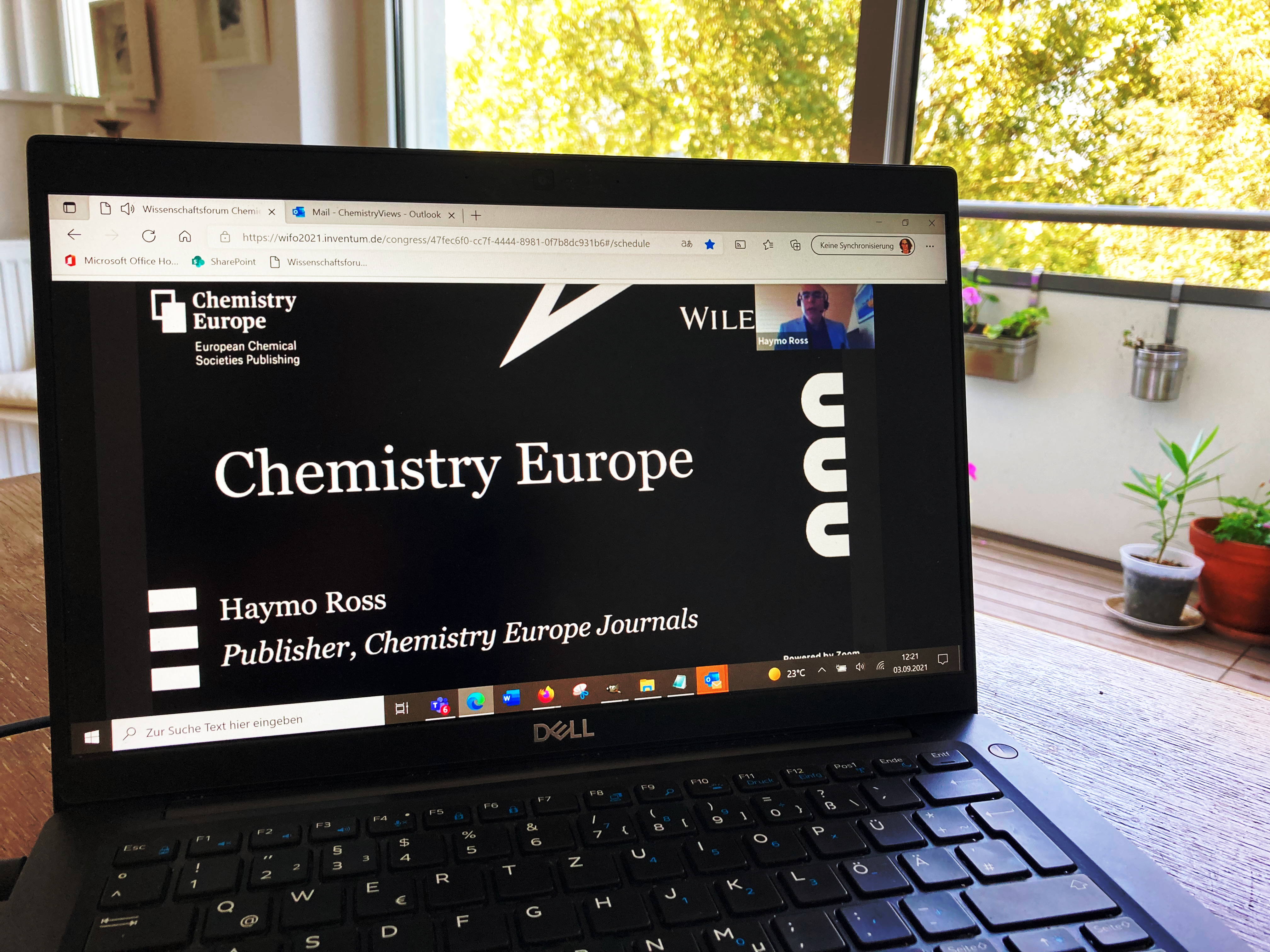
Many of us now have experience with quite a few larger and smaller online conferences. We have established our personal routines for attending meetings from the computer while managing our daily work or just lazing around in between. We have almost forgotten that we used to complain about delayed trains, overbooked flights, or terrible food, but now we are annoyed by bad Internet connections, overloaded servers, and user-unfriendly features. Suddenly, people are talking about which function is better with which conference provider and what a microphone that was not turned off revealed—of course, the latter only happens to others. And what is also talked about again and again: How nice it would be to finally meet again “in real life”, physically.
However, I enjoyed the online WiFo. At least I met many people again in video meetings and there were lots of exciting lectures and other offers. The following are some highlights from my conference visit.
Selected Talks
|
Cosmic Walk to the Origin of the Elements About 4.6 billion years ago a star exploded, 25 times as heavy as our sun. Its elements found themselves in a neighboring gas cloud and turned into our sun and its planets under their own gravity, we learn. So we are all stardust. We do not know, which form our universe has since we cannot look at the system from the outside, said Lesch in answer to a question after his talk, which was also freely accessible to the general public. It has no form. The universe is flat up to the horizon and it is so abnormally large that it is still flat behind the horizon. We are like an ant trying to figure out if the earth is flat or a sphere, which was a nice comparison. |
|
Covalent Organic Frameworks (COFs) and Molecular Weaving Reticular Chemistry is the chemistry of linking molecular building blocks by strong bonds to make crystalline extended structures [2].
Linking the building blocks by strong bonds requires overcoming what Professor Omar Yaghi, University of California, Berkeley, USA, calls crystallization challenge. He and his group did this for MOFs in the mid-1990s, when they, for the first time, showed that strong bonds between metal ions and charged organic linkers such as carboxylates can form MOF crystals. They show robust architectures due to the approach of secondary building blocks as well as ultrahigh porosity. This was the beginning of MOFs. In COFs, the building blocks are entirely organic and linked by organic bonds. In 2005, Yaghi and his team showed for the first time that 2D COFs can be crystallized, and in 2007, that 3D COFs can be crystallized. This expanded the field of organic chemistry beyond discrete molecules (0D) and polymers (1D) to infinite, layered (2D) and network (3D) structures. More recently, Omar Yaghi and his team have begun molecular weaving. In this process, COF chemistry is used to link units into threads through covalent bonds, and these threads are interlaid with other threads to form woven structures. This molecular weaving results in exceptional mechanical properties. In his talk, he shared some of his group’s findings in these two areas: The fabrication of large single crystals of COFs, the first molecular weavings, and the significant expansion of the structural complexity of COFs through the construction of highly valent nodes, i.e., molecular weaving. The idea in molecular weaving is that the building units involve the interlacing or this up-and-down intersection typical for weaving. Molecules with this geometry and this typology are linked together using COF chemistry and in the end, you have a woven structure without actually having to weave a thread in and out. In 2016, the reciprocally interacting phenanthroline complex Cu(PDB)2(BF4) was used. The phenanthroline ligands direct the addition of organic linkers via imine bonds to produce helical organic threads with woven structures. The copper(I) ions can be reversibly removed and added without loss of the COF structure. The demetalation is accompanied by a tenfold increase in elasticity, so you can switch between the crystallized and the completely organic woven structure [4]. This means they have combined the robustness of COVs with the flexibility and the dynamics that molecular weaving provides. They think weaving or interlacing is yet another strategy for obtaining dynamics in extended structures. As long as you can control the angle between the intersections and the linkers you can come up with many different structures and every structure, every network you can imagine can be woven, Omar Yaghi said. |
|
Artificial Photosynthesis – Converting CO2 Into Specialty Chemicals A pilot plant started operations in 2020 and is located in Marl at Evonik’s largest site. It consists of a CO electrolyzer developed by Siemens Energy, a water electrolyzer, and a bioreactor using Evonik’s know-how. In the solar-energy-powered electrolyzers, CO2 and water are converted into CO and H2 using electricity. This synthesis gas is used by selected and designed bacteria strains to produce specialty chemicals, initially for research purposes. These are, for example, starting materials for special plastics or food supplements. The project is funded by Germany’s Federal Ministry of Education and Research (BMBF). |
|
Chemistry at the Deutsches Museum Redesigned The first chemistry exhibition showed stagings of historical and, at the time, modern laboratories. At the same time, products and plants of the chemical industry were shown. This aspect was further strengthened in the following years. In 1972, a strictly didactic exhibition of scientific chemistry was opened. It was a wonderful playground for chemists, where chemical experiments could be started in the showcase at the push of a button, and was pretty to look at but not very enlightening for non-chemists. The new exhibition starting in 2021 will change that. With modern and historical exhibits and surprising phenomena to interact with, it will clearly show what areas have to do with chemistry—such as leisure, nutrition, cosmetics, high-tech communication, and transport. A visitors’ laboratory, a lecture hall for experimental lectures, and the reconstruction of three historical laboratories complete the exhibition, which will be unique in this variety worldwide. The replica of the Liebig Laboratory currently kept at the University of Gießen will then be replaced by the historical laboratory in Munich. The opening will be in 2022. |
|
Therapeutic Strategy for a Hepatitis B Cure
For HBV, it is particularly challenging to develop therapies because the DNA virus has a very complex life cycle and a unique way of controlling the host’s immune response. The virus produces new infectious viruses, generates viral proteins that bypass the host’s immune response, deposits a reservoir of stable genetic material in the nucleus of a liver cell, and integrates important parts of its genetic material into the host genome. The current standard therapy for HBV, primarily uses nucleoside analogs that work by inhibiting the viral polymerase. These drugs significantly, but not completely, reduce virus replication. According to Michael Sofia and the approach his company is taking, a therapeutic strategy requires a combination of agents with different mechanisms of action. They have several programs in development, including an oral capsid inhibitor designed to completely shut down the production of new virions by preventing the assembly of functional viral capsids. Currently, the 3rd generation of this drug is in clinical trials. Capsid inhibitors inhibit the uncoating step of the viral life cycle, thereby reducing the formation of new covalently closed circular DNA (cccDNA), the viral reservoir found in the nucleus of infected cells and the template for viral antigens and infectious viruses. Understanding of the molecular biology of cccDNA and the ability to effectively screen compounds for cccDNA inhibition has been limited. However, the company believes that significant progress is being made on delivering an HBV cure.
|
What Was There Besides the Lectures?
In addition to the presentations, there were exhibition booths, more than 200 posters in the poster hall, the aforementioned Meet & Mingle rooms, a job market informing about career opportunities in Germany, and the opportunity to directly chat or video-chat individually with other attendees. And there were various special events, among them the ChemSlam and a panel discussion.
ChemSlam with Cats and Phosphate Pair Therapists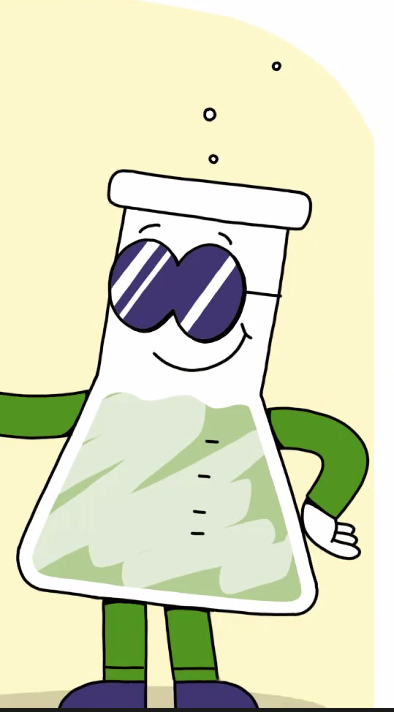
This time, the audience learned about the relationships of diphosphanes and their binding difficulties, OME and OMG and cats and catalysts, how chemistry helps in the kitchen, and how to remove nanoparticles from skin. The winning slammer was Natalia Simitsis from RWTH Aachen University with her story on research into oxymethylene ethers (OMEs) to make diesel vehicles greener. Adding OMEs in conventional diesel fuel has the potential to reduce soot formation during the combustion in a diesel engine and by this reduce NOx pollutants. To produce OMEs sustainably from CO2, you need catalysts—or cats, as we learn … Oh my God (OMG) 🙂
The slam was moderated by Richard Göttlich, Professor at the University of Gießen, Germany.
Panel Discussion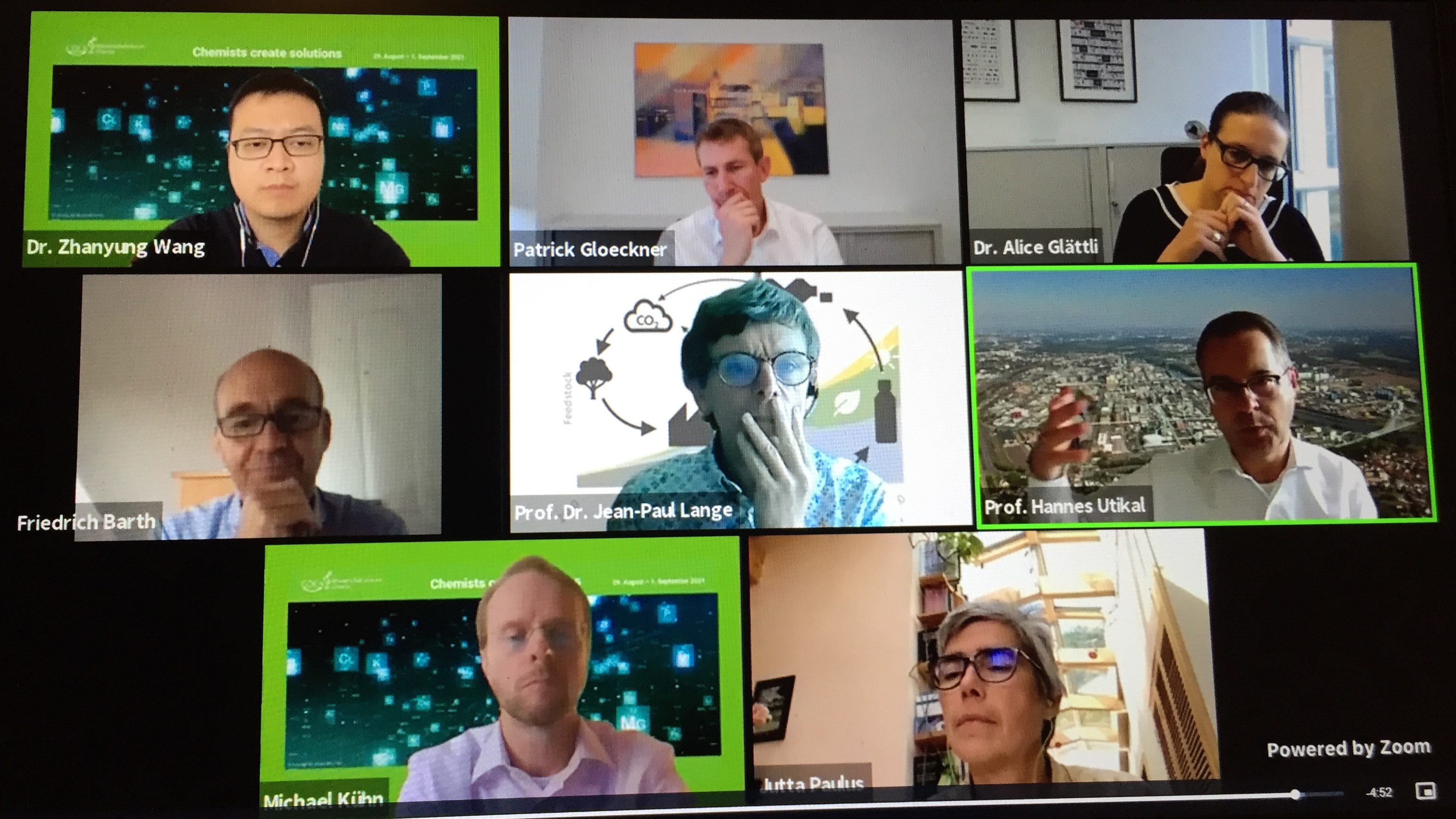
It does not help if we have big goals or if we make our processes just a little bit greener. We really need to rethink. Rethinking the system, rethinking materials, establishing new trust-based cooperation along the value chain, taking responsibility for the full lifecycle of a product, … and we need pioneers who set examples. Germany and Europe as major players in the chemical industry have the power to do so, to establish regulations, to close the gap between theory and practice. Some felt that policy is lagging behind the activities of many companies, for example, in regulating the use of waste as a feedstock.
The topic is also to be taken up further in the GDCh. The Sustainability Taskforce of the JungChemikerForum (JCF, Young Chemists’ Network) is already engaged in the topic and is thinking about what they can do to shape a more sustainable future. They are looking for ideas and committed young chemists who would like to contribute to regional guidelines, national and international opinion formation and representation, etc.
Selected Awards
Traditionally, many outstanding chemists are honored for their work at the WiFo. This year was no exception. Only the award ceremonies were different: In the run-up, the awardees and laudators were invited individually to Frankfurt to the GDCh offices for their award ceremony and an interview. Both occasions were filmed and the videos presented at the WiFo. The interviews can still be seen on the GDCh YouTube page [6]. You also find links to them on ChemistryViews [7].
Evamarie Hey-Hawkins, Professor at the University of Leipzig, Germany, was awarded the Karl Ziegler Prize for her pioneering research in the field of reactive transition metal–phosphorus bonds in metal-phosphanido complexes and her innovative research approaches [8].
Petra Mischnick, Professor at the Technical University of Braunschweig, Germany, has received the inaugural Hildegard Hamm-Brücher Award for equal opportunities in chemistry for initiating the Agnes Pockels student laboratory at the Technical University of Braunschweig, which was one of the first of its kind and has had a broad impact [9].
Dr. Mai Thi Nguyen-Kim, chemist, YouTuber, and science communicator, has received the GDCh award for journalists and writers for her journalistic work, in which she communicates scientific concepts with competence and humor to people of all ages [10].
Stefanie Dehnen, Professor at the University of Marburg, Germany, has received the Alfred Stock Memorial Award 2020 for her research on cluster chemistry [11].
Professor Herbert Waldmann, Max Planck Institute of Molecular Physiology, Dortmund, Germany, has received the Liebig Memorial Medal 2020 for the development of new concepts for the production of natural substance-based compound libraries, as well as for his synthesis methods for the production of lipidated peptides and proteins for the study of cancer-relevant G proteins, such as the Ras/RasG system [12].
Professor Peter H. Seeberger, Max Planck Institute of Colloids and Interfaces, Potsdam, Germany, has received the Emil Fischer Medal for his groundbreaking contributions to the synthesis of complex carbohydrates and the chemical biology of carbohydrates, especially through the development of automated methods [13].
Omar M. Yaghi, Professor at the University of California, Berkeley, USA, has received the August Wilhelm von Hofmann Medal for his outstanding work on metal-organic frameworks (MOFs) and covalent organic frameworks (COFs) and his pioneering work on molecular “weaving” [14].
Figure: From top left to bottom right: Professor Omar M. Yaghi, University of California, Berkeley, USA, Professor Peter H. Seeberger, Max Planck Institute of Colloids and Interfaces, Potsdam, Germany, Professor Herbert Waldmann, Max Planck Institute of Molecular Physiology, Dortmund, Germany, Professor Stefanie Dehnen, University of Marburg, Germany, Professor Petra Mischnick, Technical University of Braunschweig, Germany, and Professor Evamarie Hey-Hawkins, University of Leipzig, Germany.
Dr. Alexander Hinz, Karlsruhe Institute of Technology (KIT), Germany, is the winner of the 2021 EurJIC–Wöhler Young Investigator Prize. The award is offered by the Wöhler Association for Inorganic Chemistry of the GDCh and the European Journal of Inorganic Chemistry (EurJIC), one of the Chemistry Europe journals, and recognizes outstanding publications [15,16].
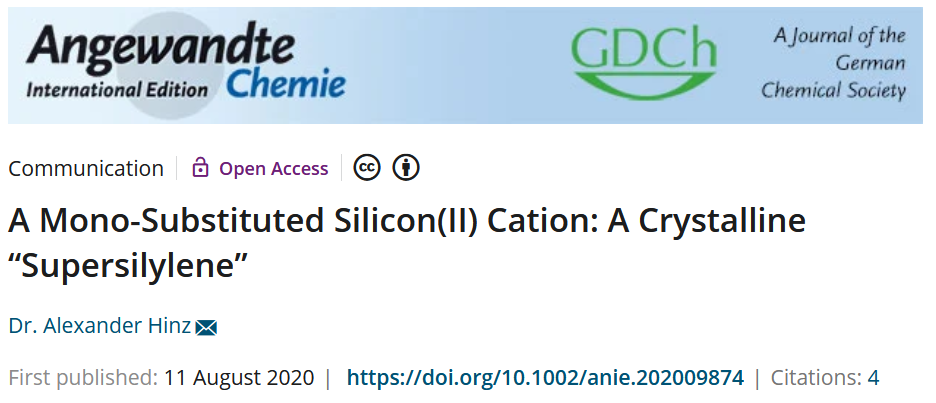
And When Do We Meet Again Physically?
In 2023, the WiFo (Science Forum Chemistry) will take place in Leipzig, Germany from September 2 to 6.
And we can be curious: Will it be like it used to be at physical events before the coronavirus pandemic? Or maybe we will be much more excited about networking opportunities and discussions and prefer to listen to lectures, at least longer ones, online? Let’s wait and see.
The WiFo 2021 program will be available as a video stream until September 8.
References
[1] Event: 16th Austrian Chemistry Days
[2] Omar M Yaghi, Michael O’Keeffe, Nathan W Ockwig, Hee K Chae, Mohamed Eddaoudi, Jaheon Kim, Reticular synthesis and the design of new materials, Nature 2003. https://doi.org/10.1038/nature01650
[3] Hyunho Kim, Sameer R. Rao, Eugene A. Kapustin, Lin Zhao, Sungwoo Yang, Omar M. Yaghi, Evelyn N. Wang, Adsorption-based atmospheric water harvesting device for arid climates, Nature Communic. 2018. https://doi.org/10.1038/s41467-018-03162-7
[4] Yuzhong Liu Yanhang Ma Yingbo Zhao Xixi Sun Felipe Gándara Hiroyasu Furukawa Zheng, Liu Hanyu Zhu Chenhui Zhu Kazutomo, Suenaga Peter Oleynikov Ahmad S. Alshammari Xiang Zhang Osamu Terasaki, Omar M. Yaghi, Weaving of organic threads into a crystalline covalent organic framework, Science 2016. https://doi.org/10.1126/science.aad4011
[5] Martin Scheringer, Environmental chemistry and ecotoxicology: in greater demand than ever, Environmental Sciences Europe 2017. https://doi.org/10.1186/s12302-016-0101-x
[6] YouTube page of GDCh with Awardee Interviews (accessed September 3, 2021)
[7] Awardee videos on ChemistryViews (accessed September 3, 2021)
[8] Karl Ziegler Prize for Evamarie Hey-Hawkins, ChemistryViews 2021.
[9] Inaugural Hildegard Hamm-Brücher Award for Equal Opportunities in Chemistry, ChemistryViews 2021.
[10] GDCh Award for Journalists and Writers for Mai Thi Nguyen-Kim, ChemistryViews 2021.
[11] Alfred Stock Memorial Award for Stefanie Dehnen, ChemistryViews 2021.
[12] Liebig Memorial Medal for Herbert Waldmann, ChemistryViews 2021.
[13] Emil Fischer Medal for Peter H. Seeberger, ChemistryViews 2021.
[14] August Wilhelm von Hofmann Medal for Omar M. Yaghi, ChemistryViews 2021.
[15] 2021 EurJIC–Wöhler Young Investigator Prize, ChemistryViews 2021.
[16] Alexander Hinz, A Mono-Substituted Silicon(II) Cation: A Crystalline “Supersilylenc”, Angew. Chem. Int. Ed. 2020. https://doi.org/10.1002/anie.202009874
Also of Interest
- Interview: Chemical Industry Creates Platform to Achieve Ambitious Climate Targets,
Interview with Jenna Juliane Schulte and Manfred Ritz of the German Chemical Industry Association (VCI)
ChemistryViews 2021.
https://doi.org/10.1002/chemv.202100052 - Event Highlight: GDCh’s WiFo in Aachen,
Highlights of the most important chemistry congress in the German-speaking world
ChemistryViews 2019.
https://doi.org/10.1002/chemv.201900096 - Event: GDCh-Wissenschaftsforum Chemie 2021 (WiFo 2021)
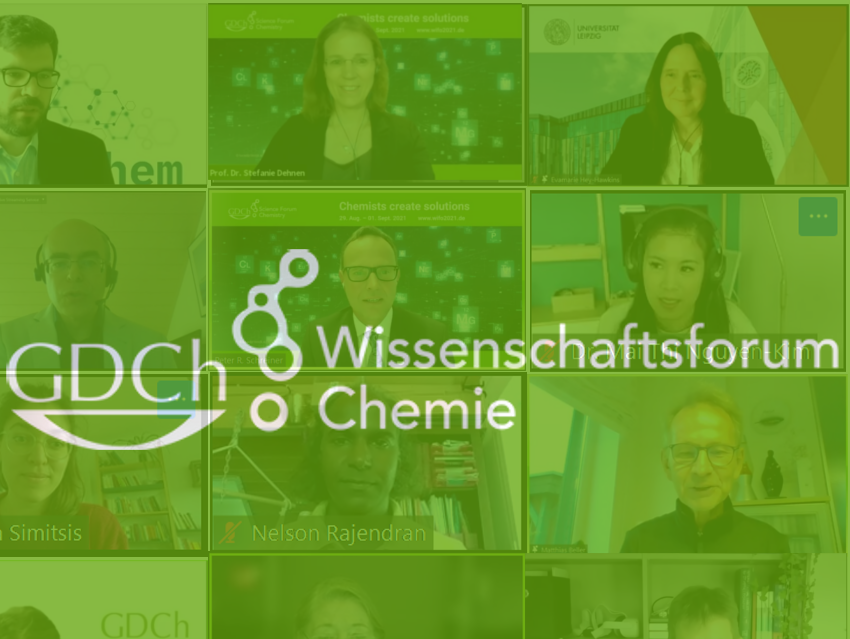
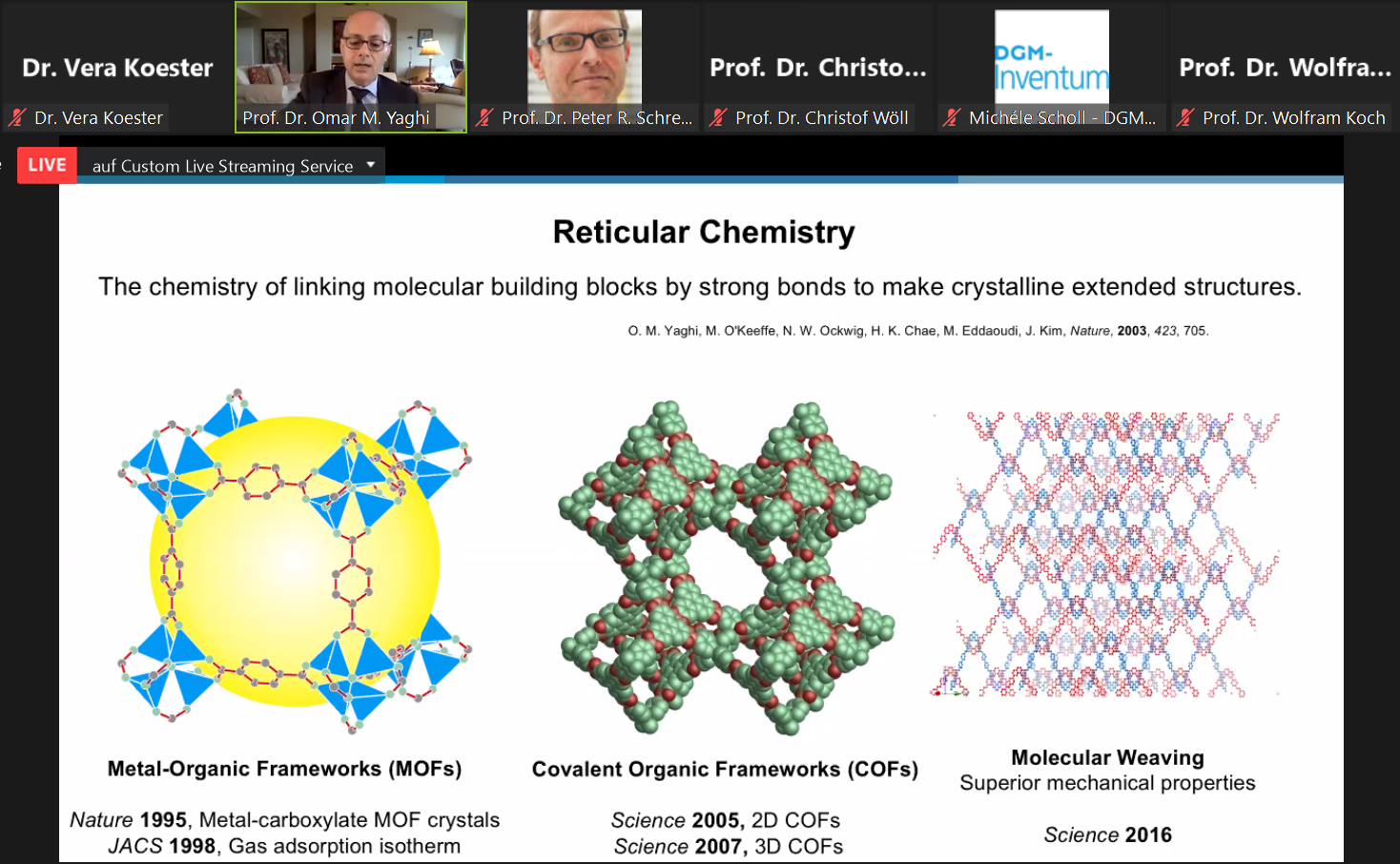 Molecular building blocks are useful so that chemists can design extended structures and materials. Connecting building blocks through strong bonds is necessary to create durable materials. For example, MOFs that capture water from dry air should withstand ambient conditions [3] and not need to be replaced for a very long time.
Molecular building blocks are useful so that chemists can design extended structures and materials. Connecting building blocks through strong bonds is necessary to create durable materials. For example, MOFs that capture water from dry air should withstand ambient conditions [3] and not need to be replaced for a very long time.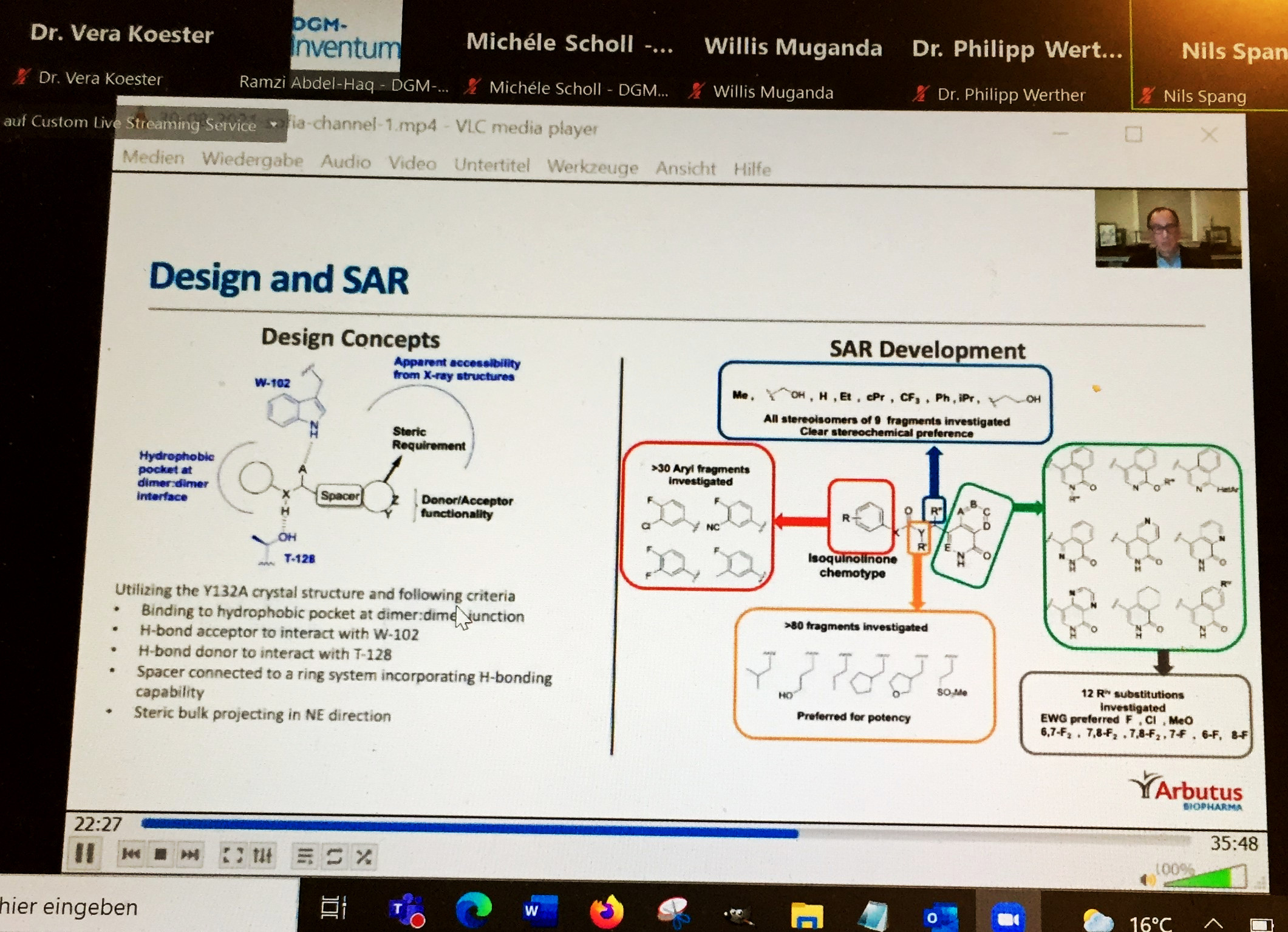 From Michael J. Sofia, Arbutus Biopharma, Warminster PA, USA, we learned that highly effective and safe antiviral therapies against HCV are available since 2013, but for people suffering from HBV infection, there is no cure although it is seen as more problematic. There are 250 million individuals chronically infected with HBC virus infection; 67 % in Asia and the Pacific Islands. Hepatitis B causes up to 700,000 deaths each year worldwide.
From Michael J. Sofia, Arbutus Biopharma, Warminster PA, USA, we learned that highly effective and safe antiviral therapies against HCV are available since 2013, but for people suffering from HBV infection, there is no cure although it is seen as more problematic. There are 250 million individuals chronically infected with HBC virus infection; 67 % in Asia and the Pacific Islands. Hepatitis B causes up to 700,000 deaths each year worldwide.